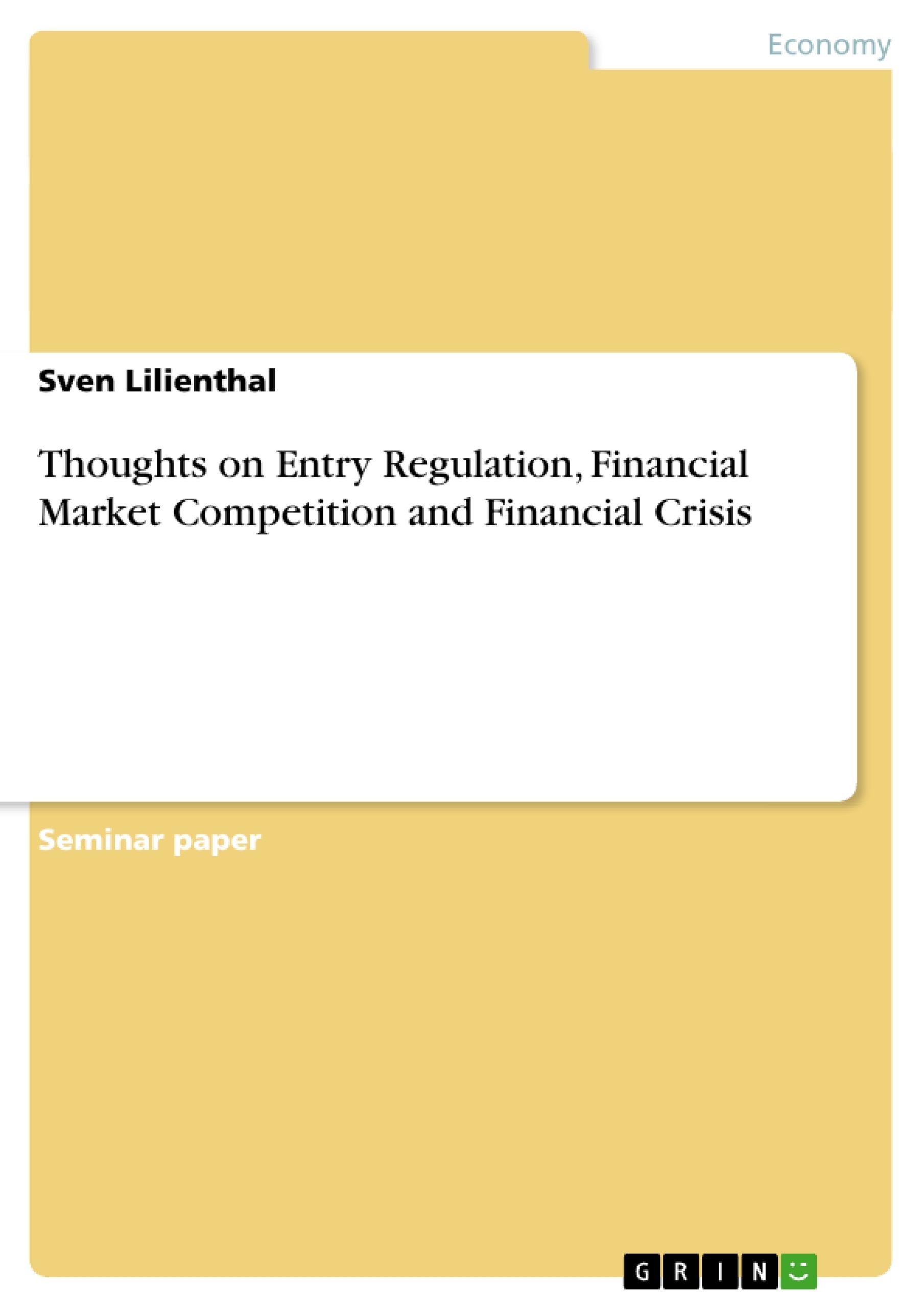This paper deals with the terms entry regulation, financial market competition and also
indicates connections to potential financial crises. Authors in research have been
attempting for years to build up a remedy for an optimal set-up.1
So, this is the reason I observe a seemingly never-ending discussion between two
unofficial parties: Neither the proponents of the concentration-stability view, neither
those of the concentration-fragility view will retreat from how to install proper
competition in order to ensure stability.
This paper also aims to understand the terms of both parties; their arguments and
whether either monopolistic structures or competition are desirable in the financial
industry.
Therefore, I lay the theoretical foundation. I demonstrate with a model of the authors
Boyd & De Nicoló that even economies with monopolistic structure are exposed to
risk-taking activities – and not only banks in competitive industries. In chapter 3, I turn
to the topic “Entry Regulation”. I unveil different yardsticks of entry regulation, reveal
some advantages and draw up my own index. I show that mainly countries that
suffered devastating crises in recent times have stringent entry regulation. This can be
shown by regarding their high capital requirements or their barriers for submitting
information of managers, future plans or composition of shareholders. I also show that
entry regulation is an appropriate means for governments to control or to curb
competition. In the last chapter, it is also shown that high entry capital requirements
prevent mainly weak or inefficient banks from entry.
In chapter 4, I present two ratios for assessing competition: The concentration ratio
(CR) and H-Statistics (H). CR is widely used in literature and defines the market share
of the largest banks in a country. By presenting CR, I also turn back to the argument
between the concentration-stability and concentration-fragility views. Moreover, I do
my part to debilitate the somewhat misleading statement that the European banking
market is in a phase of consolidation and concentration. I do this by revealing that the
concentration ratio slightly decreased in a time span of four years during the current
decade. H-Statistics is a ratio to find out more about the ferocity and contestability of a market and how market participants react to changes in output prices. I show that there
is, maybe surprisingly, no strict correlation between CR and H-Statistics.
[...]
Inhaltsverzeichnis (Table of Contents)
- 1. Introduction
- 2. Thoughts on entry regulation and competition
- 2.1. The impact of bank competition on risk taking
- 2.2. The new approach of Boyd and De Nicoló
- 2.2.1 The outcome
- 2.2.2 Assumptions of Boyd & De Nicoló
- 2.2.3 Optimisation from the borrowers' perspective
- 2.2.4 Interpretation and assessment
- 3. Entry Regulation
- 3.1 My own index for entry regulation
- 3.2 Entry regulation in LDCs and SSACs
- 3.3 Entry regulation in Europe
- 3.4 Short summary on entry regulation
- 4. How to measure competition
- 4.1 Concentration Ratio and Concentration curve
- 4.2 Evaluating the meaning of concentration ratios
- 4.3 The "consolidation and concentration wave"
- 4.4 Examples for high and low concentration
- 4.5 H-Statistics
- 4.6 Coherency between H-Statistics and CR5
- 5. Final thoughts on entry regulation, competition and risk taking
Zielsetzung und Themenschwerpunkte (Objectives and Key Themes)
This term paper examines the relationship between entry regulation, financial market competition, and the risk of financial crises. The paper aims to analyze the impact of bank competition on risk-taking behavior and to develop a framework for assessing entry regulation in different countries. * The impact of bank competition on risk-taking. * The development and application of an index for assessing entry regulation. * The analysis of entry regulation in various geographical contexts (LDCs, SSACs, Europe). * Methods for measuring competition in financial markets (concentration ratios, H-statistics). * The relationship between competition, regulation, and financial stability.Zusammenfassung der Kapitel (Chapter Summaries)
Chapter 1 introduces the topic and outlines the paper's objectives. Chapter 2 discusses the theoretical link between bank competition and risk-taking, introducing the Boyd and De Nicoló approach. Chapter 3 presents a novel index for measuring entry regulation and examines its application in different countries. Chapter 4 explores various methods for measuring competition in financial markets, including concentration ratios and H-statistics.Schlüsselwörter (Keywords)
Entry regulation, financial market competition, financial crisis, bank competition, risk-taking, concentration ratios, H-statistics, LDCs, SSACs, Europe.- Citation du texte
- Sven Lilienthal (Auteur), 2009, Thoughts on Entry Regulation, Financial Market Competition and Financial Crisis, Munich, GRIN Verlag, https://www.grin.com/document/124318



